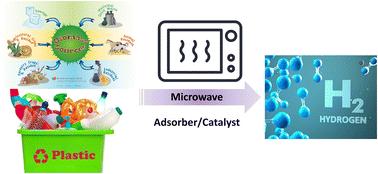微波辅助热解生物质和塑料废物制氢
IF 9.2
1区 化学
Q1 CHEMISTRY, MULTIDISCIPLINARY
引用次数: 0
摘要
发展氢能是实现碳中和的关键途径,提供零碳、高效的清洁能源解决方案。增强能源安全,促进工业、交通等领域绿色转型,形成新的经济增长点。微波辅助热解是一种新兴的热化学技术,它将富氢资源高效地转化为H2和高价值的碳材料,受到了广泛的关注。微波加热提高了热量分布的均匀性。微波加热时,电磁能量转化为分子动能。介电损耗是指介电材料以热或其他形式耗散其电磁能量的现象。介质损耗是所有材料所固有的,是自然发生的。综述了生物质和塑料废弃物微波热解制氢的研究进展和面临的关键挑战。一般来说,微波热解是对原料的选择性加热。微波热解的参数包括反应温度、反应时间、微波功率的供给、微波原料的来源、原料的粒度、原料的混合比、原料的介电常数、原料的预处理、催化剂和微波吸收剂的使用等。阐明了这些参数对微波辅助热解制氢的影响。微波辅助催化废塑料和生物质热解制氢具有能耗低、可减少焦油生成的优势,与常规热解相比,提高了H2的收率和选择性。主要挑战包括在大型反应器中实现均匀加热,这是由于原料的介电特性变化和微波穿透有限,这可能会导致热点和产品质量不一致。原料成分、水分和粒度的变化使稳定的物料流和连续的进料系统复杂化。微波发电需要昂贵的设备和优化的能源使用,以确保经济可行性。由于加热不均匀和原料多样性,以及管理碳副产品,保持一致的产品质量是困难的。展望了各种资源微波辅助热解的未来发展方向,推动制氢向高效、节能、低碳方向发展。本文章由计算机程序翻译,如有差异,请以英文原文为准。

Microwave-assisted pyrolysis of biomass and plastic wastes for hydrogen production
The development of hydrogen energy is a key path to achieving carbon neutrality, providing zero-carbon and efficient clean energy solutions. Moreover, it can enhance energy security, promote green transformation in industry, transportation and other fields, and form new economic growth points. Microwave-assisted pyrolysis is an emerging thermochemical technology that has gained significant attention for efficiently converting hydrogen-rich resources to H2 and high-value carbon materials. Microwave heating enhances the uniformity of heat distribution. Electromagnetic energy is converted to molecular kinetic energy in microwave heating. Dielectric loss is the phenomenon in which a dielectric material dissipates its electromagnetic energy in the form of heat or other forms. Dielectric loss is inherent to all materials and occurs naturally. This paper summarizes the research advances and key challenges in the microwave-assisted pyrolysis of biomass and plastic wastes for H2 production. In general, microwave pyrolysis is the selective heating of feedstocks. The parameters of microwave pyrolysis include the reaction temperature, the reaction time, the supply of microwave power, the origin of the microwave feedstock, the particle size of the feedstock, the mixing ratios of feedstock, the dielectric constant of the feedstock, the feedstock pretreatment, and the use of catalysts and microwave absorbers. The effects of these parameters on H2 production from microwave-assisted pyrolysis are clarified. H2 production through microwave-assisted catalytic pyrolysis of waste plastic and biomass has advantages in terms of lower energy consumption and potential for reducing tar formation, thus increasing the yield and selectivity of H2 compared with conventional pyrolysis. Key challenges include achieving uniform heating in large reactors due to variable dielectric properties of feedstocks and limited microwave penetration, which risks hot spots and inconsistent product quality. Feedstock variability in composition, moisture, and size complicates stable material flow and continuous feeding systems. Microwave generation demands costly equipment and optimized energy use to ensure economic viability. Maintaining consistent product quality is difficult due to uneven heating and feedstock diversity, alongside managing the carbon byproducts. Furthermore, the future directions in the microwave-assisted pyrolysis of each resource are discussed, thus promoting H2 production toward high-efficiency, energy-saving and low-carbon development.
求助全文
通过发布文献求助,成功后即可免费获取论文全文。
去求助
来源期刊

Green Chemistry
化学-化学综合
CiteScore
16.10
自引率
7.10%
发文量
677
审稿时长
1.4 months
期刊介绍:
Green Chemistry is a journal that provides a unique forum for the publication of innovative research on the development of alternative green and sustainable technologies. The scope of Green Chemistry is based on the definition proposed by Anastas and Warner (Green Chemistry: Theory and Practice, P T Anastas and J C Warner, Oxford University Press, Oxford, 1998), which defines green chemistry as the utilisation of a set of principles that reduces or eliminates the use or generation of hazardous substances in the design, manufacture and application of chemical products. Green Chemistry aims to reduce the environmental impact of the chemical enterprise by developing a technology base that is inherently non-toxic to living things and the environment. The journal welcomes submissions on all aspects of research relating to this endeavor and publishes original and significant cutting-edge research that is likely to be of wide general appeal. For a work to be published, it must present a significant advance in green chemistry, including a comparison with existing methods and a demonstration of advantages over those methods.
 求助内容:
求助内容: 应助结果提醒方式:
应助结果提醒方式:


